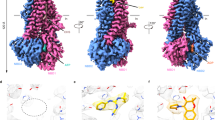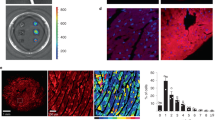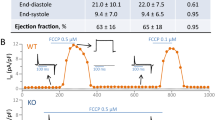Abstract
Prevailing data suggest that sarcolemmal ATP-sensitive (KATP) channels in the adult heart consist of Kir6.2 and SUR2A subunits, but the expression of other KATP channel subunits (including SUR1, SUR2B, and Kir6.1) is poorly defined. The situation is even less clear for the immature heart, which shows a remarkable resistance to hypoxia and metabolic stress. The hypoxia-induced action potential shortening and opening of sarcolemmal KATP channels that occurs in adults is less prominent in the immature heart. This might be due in part to the different biophysical and pharmacological properties of KATP channels of immature and adult KATP channels. Because these properties are largely conferred by subunit composition, it is important to examine the relative expression levels of the various KATP channel subunits during maturation. We therefore used RNAse protection assays, reverse transcription–PCR approaches, and Western blotting to characterize the mRNA and protein expression profiles of KATP channel subunits in fetal, neonatal, and adult mouse heart. Our data indicate that each of the KATP channel subunits (Kir6.1, Kir6.2, SUR1, SUR2A, and SUR2B) is expressed in the mouse heart at all of the developmental time points studied. However, the expression level of each of the subunits is low in the fetal heart and progressively increases with maturation. Each of the subunits seems to be expressed in ventricular myocytes with a subcellular expression pattern matching that found in the adult. Our data suggest that the KATP channel composition may change during maturation, which has important implications for KATP channel function in the developing heart.
Similar content being viewed by others
Log in or create a free account to read this content
Gain free access to this article, as well as selected content from this journal and more on nature.com
or
Abbreviations
- KATP:
-
ATP-sensitive K+
- Kir6:
-
inward rectifying K+ channel, subfamily 6
- SUR:
-
sulfonylurea receptor
References
Davies MP, An RH, Doevendans P, Kubalak S, Chien KR, Kass RS 1996 Developmental changes in ionic channel activity in the embryonic murine heart. Circ Res 78: 15–25
Xie LH, Takano M, Noma A 1997 Development of inwardly rectifying K+ channel family in rat ventricular myocytes. Am J Physiol 272: H1741–H1750
Chen FH, Wetzel GT, Friedman WF, Klitzner TS 1992 ATP-sensitive potassium channels in neonatal and adult rabbit ventricular myocytes. Pediatr Res 32: 230–235
Baron A, van Bever L, Monnier D, Roatti A, Baertschi AJ 1999 A novel K(ATP) current in cultured neonatal rat atrial appendage cardiomyocytes. Circ Res 85: 707–715
Yokoshiki H, Sunagawa M, Seki T, Sperelakis N 1999 Antisense oligodeoxynucleotides of sulfonylurea receptors inhibit ATP-sensitive K+ channels in cultured neonatal rat ventricular cells. Pflugers Arch 437: 400–408
Nichols CG, Lopatin AN 1997 Inward rectifier potassium channels. Annu Rev Physiol 59: 171–191
Isomoto S, Kondo C, Kurachi Y 1997 Inwardly rectifying potassium channels: their molecular heterogeneity and function. Jpn J Physiol 47: 11–39
Babenko AP, Aguilar-Bryan L, Bryan J 1998 A view of sur/KIR6.X, KATP channels. Annu Rev Physiol 60: 667–687
Aguilar-Bryan L, Clement JP 4th, Gonzalez G, Kunjilwar K, Babenko A, Bryan J 1998 Toward understanding the assembly and structure of KATP channels. Physiol Rev 78: 227–245
Inagaki N, Gonoi T, Clement JP 4th, Namba N, Inazawa J, Gonzalez G, Aguilar-Bryan L, Seino S, Bryan J 1995 Reconstitution of IKATP: an inward rectifier subunit plus the sulfonylurea receptor. Science 270: 1166–1170
Isomoto S, Kondo C, Yamada M, Matsumoto S, Higashiguchi O, Horio Y, Matsuzawa Y, Kurachi Y 1996 A novel sulfonylurea receptor forms with BIR (Kir6.2) a smooth muscle type ATP-sensitive K+ channel. J Biol Chem 271: 24321–24324
Chutkow WA, Makielski JC, Nelson DJ, Burant CF, Fan Z 1999 Alternative splicing of sur2 Exon 17 regulates nucleotide sensitivity of the ATP-sensitive potassium channel. J Biol Chem 274: 13656–13665
Makhina EN, Nichols CG 1998 Independent trafficking of KATP channel subunits to the plasma membrane. J Biol Chem 273: 3369–3374
Garlid KD, Paucek P, Yarov-Yarovoy V, Sun X, Schindler PA 1993 The mitochondrial KATP channel as a receptor for potassium channel openers. J Biol Chem 271: 8796–8799
Gribble FM, Tucker SJ, Haug T, Ashcroft FM 1998 MgATP activates the beta cell KATP channel by interaction with its SUR1 subunit. Proc Natl Acad Sci USA 95: 7185–7190
Babenko AP, Gonzalez G, Aguilar-Bryan L, Bryan J 1999 Sulfonylurea receptors set the maximal open probability, ATP sensitivity and plasma membrane density of K-ATP channels. FEBS Lett 445: 131–136
Babenko AP, Gonzalez G, Aguilar-Bryan L, Bryan J 1998 Reconstituted human cardiac KATP channels: functional identity with the native channels from the sarcolemma of human ventricular cells. Circ Res 83: 1132–1143
Cui Y, Giblin JP, Clapp LH, Tinker A 2001 A mechanism for ATP-sensitive potassium channel diversity: functional coassembly of two pore-forming subunits. Proc Natl Acad Sci USA 98: 729–734
Brock R, Hamelers IH, Jovin TM 1999 Comparison of fixation protocols for adherent cultured cells applied to a GFP fusion protein of the epidermal growth factor receptor. Cytometry 35: 353–362
Pountney DJ, Sun ZQ, Porter LM, Nitabach MN, Nakamura TY, Holmes D, Rosner E, Kaneko M, Manaris T, Holmes TC, Coetzee WA 2001 Is the molecular composition of K(ATP) channels more complex than originally thought?. J Mol Cell Cardiol 33: 1541–1546
Yoshida H, Feig JE, Morrissey A, Ghiu IA, Artman M, Coetzee WA 2004 Native K(ATP) Channels of primary human coronary artery endothelial cells consist of a heteromultimeric complex of Kir6.1, Kir6.2, and SUR2B subunits. J Mol Cell Cardiol 37: 857–869
Morrissey A, Rosner E, Lanning J, Parachuru L, Dhar Chowdhury P, Han S, Lopez G, Tong X, Yoshida H, Nakamura TY, Artman M, Giblin JP, Tinker A, Coetzee WA 2004 Immunolocalization of K(ATP) channel subunits in mouse and rat cardiac myocytes and the coronary vasculature. BMC Physiol 5: 1
Chutkow WA, Simon MC, Le Beau MM, Burant CF 1996 Cloning, tissue expression, and chromosomal localization of SUR2, the putative drug-binding subunit of cardiac, skeletal muscle, and vascular KATP channels. Diabetes 45: 1439–1445
Shyng S, Nichols CG 1997 Octameric stoichiometry of the KATP channel complex. J Gen Physiol 110: 655–664
Seino S, Miki T 2003 Physiological and pathophysiological roles of ATP-sensitive K+ channels. Prog Biophys Mol Biol 81: 133–176
Sakura H, Ammala C, Smith PA, Gribble FM, Ashcroft FM 1995 Cloning and functional expression of the cDNA encoding a novel ATP-sensitive potassium channel subunit expressed in pancreatic beta-cells, brain, heart and skeletal muscle. FEBS Lett 377: 338–344
Akao M, Otani H, Horie M, Takano M, Kuniyasu A, Nakayama H, Kouchi I, Murakami T, Sasayama S 1997 Myocardial ischemia induces differential regulation of KATP channel gene expression in rat hearts. J Clin Invest 100: 3053–3059
Ranki HJ, Budas GR, Crawford RM, Jovanovic A 2001 Gender-specific difference in cardiac ATP-sensitive K+ channels. J Am Coll Cardiol 38: 906–915
Brundel BJ, Van Gelder IC, Henning RH, Tuinenburg AE, Wietses M, Grandjean JG, Wilde AA, Van Gilst WH, Crijns HJ 2001 Alterations in potassium channel gene expression in atria of patients with persistent and paroxysmal atrial fibrillation: differential regulation of protein and mRNA levels for K+ channels. J Am Coll Cardiol 37: 926–932
Smolich JJ 1995 Ultrastructural and functional features of the developing mammalian heart: a brief overview. Reprod Fertil Dev 7: 451–461
Haddock PS, Coetzee WA, Cho E, Porter L, Katoh H, Bers DM, Jafri MS, Artman M 1999 Sub-cellular [Ca2+]i gradients during excitation-contraction coupling in newborn rabbit ventricular myocytes. Circ Res 85: 415–427
Schnitzler MM, Derst C, Daut J, Preisig-Muller R 2000 ATP-sensitive potassium channels in capillaries isolated from guinea-pig heart. J Physiol (Lond) 525: 307–317
Miki T, Suzuki M, Shibasaki T, Uemura H, Sato T, Yamaguchi K, Koseki H, Iwanaga T, Nakaya H, Seino S 2002 Mouse model of Prinzmetal angina by disruption of the inward rectifier Kir6.1. Nat Med 8: 466–472
Suzuki M, Kotake K, Fujikura K, Inagaki N, Suzuki T, Gonoi T, Seino S, Takata K 1997 Kir6.1: A possible subunit of ATP-sensitive K+ channels in mitochondria. Biochem Biophys Res Commun 241: 693–697
Singh H, Hudman D, Lawrence CL, Rainbow RD, Lodwick D, Norman RI 2003 Distribution of Kir6.0 and SUR2 ATP-sensitive potassium channel subunits in isolated ventricular myocytes. J Mol Cell Cardiol 35: 445–459
Lacza Z, Snipes JA, Miller AW, Szabo C, Grover G, Busija DW 2003 Heart mitochondria contain functional ATP-dependent K+ channels. J Mol Cell Cardiol 35: 1339–1347
Seharaseyon J, Ohler A, Sasaki N, Fraser H, Sato T, Johns DC, O'Rourke B, Marban E 2000 Molecular composition of mitochondrial ATP-sensitive potassium channels probed by viral Kir gene transfer. J Mol Cell Cardiol 32: 1923–1930
Kuniyasu A, Kaneko K, Kawahara K, Nakayama H 2003 Molecular assembly and subcellular distribution of ATP-sensitive potassium channel proteins in rat hearts. FEBS Lett 552: 259–263
Seharaseyon J, Sasaki N, Ohler A, Sato T, Fraser H, Johns DC, O'Rourke B, Marban E 2000 Evidence against functional heteromultimerization of the KATP channel subunits Kir6.1 and Kir6.2. J Biol Chem 275: 17561–17565
Lu C, Halvorsen SW 1997 Channel activators regulate ATP-sensitive potassium channel (Kir6.1) expression in chick cardiomyocytes. FEBS Lett 412: 121–125
Kono Y, Horie M, Takano M, Otani H, Xie LH, Akao M, Tsuji K, Sasayama S 2000 The properties of the Kir6.1–6.2 tandem channel co-expressed with SUR2A. Pflugers Arch 440: 692–698
Babenko AP, Gonzalez GC, Bryan J 2000 Hetero-concatemeric KIR6.X4/SUR1 channels display distinct conductivities but uniform ATP inhibition. J Biol Chem 275: 31563–31566
Zerangue N, Schwappach B, Jan YN, Jan LY 1999 A new ER trafficking signal regulates the subunit stoichiometry of plasma membrane KATP channels. Neuron 22: 537–548
Kondo C, Repunte VP, Satoh E, Yamada M, Horio Y, Matsuzawa Y, Pott L, Kurachi Y 1998 Chimeras of Kir6.1 and Kir6.2 reveal structural elements involved in spontaneous opening and unitary conductance of the ATP-sensitive K+ channels. Receptors Channels 6: 129–140
Repunte VP, Nakamura H, Fujita A, Horio Y, Findlay I, Pott L, Kurachi Y 1999 Extracellular links in Kir subunits control the unitary conductance of SUR/Kir6.0 ion channels. EMBO J 18: 3317–3324
Giblin JP, Leaney JL, Tinker A 1999 The molecular assembly of ATP-sensitive potassium channels. Determinants on the pore forming subunit. J Biol Chem 274: 22652–22659
Miura H, Wachtel RE, Loberiza FR Jr, Saito T, Miura M, Nicolosi AC, Gutterman DD 2003 Diabetes mellitus impairs vasodilation to hypoxia in human coronary arterioles: reduced activity of ATP-sensitive potassium channels. Circ Res 92: 151–158
Yamada M, Isomoto S, Matsumoto S, Kondo C, Shindo T, Horio Y, Kurachi Y 1997 Sulphonylurea receptor 2B and Kir6.1 form a sulphonylurea- sensitive but ATP-insensitive K+ channel. J Physiol (Lond) 499: 715–720
Chutkow WA, Pu J, Wheeler MT, Wada T, Makielski JC, Burant CF, McNally EM 2002 Episodic coronary artery vasospasm and hypertension develop in the absence of Sur2 K(ATP) channels. J Clin Invest 110: 203–208
Ammala C, Moorhouse A, Ashcroft FM 1996 The sulphonylurea receptor confers diazoxide sensitivity on the inwardly rectifying K+ channel Kir6.1 expressed in human embryonic kidney cells. J Physiol 494: 709–714
Gribble FM, Tucker SJ, Seino S, Ashcroft FM 1998 Tissue specificity of sulfonylureas: studies on cloned cardiac and beta- cell K(ATP) channels. Diabetes 47: 1412–1418
Huynh TV, Chen FH, Wetzel GT, Friedman WF, Klitzner TS 1992 Developmental changes in membrane Ca2+ and K+ currents in fetal, neonatal, and adult rabbit ventricular myocytes. Circ Res 70: 508–515
Reder RF, Miura DS, Danilo P, Rosen MR 1981 The electrophysiological properties of normal neonatal and adult canine cardiac Purkinje fibers. Circ Res 48: 658–668
Miki T, Nagashima K, Tashiro F, Kotake K, Yoshitomi H, Tamamoto A, Gonoi T, Iwanaga T, Miyazaki J, Seino S 1998 Defective insulin secretion and enhanced insulin action in KATP channel-deficient mice. Proc Natl Acad Sci USA 95: 10402–10406
Zingman LV, Hodgson DM, Bast PH, Kane GC, Perez-Terzic C, Gumina RJ, Pucar D, Bienengraeber M, Dzeja PP, Miki T, Seino S, Alekseev AE, Terzic A 2002 Kir6.2 is required for adaptation to stress. Proc Natl Acad Sci U S A 99: 13278–13283
Vleugels A, Carmeliet E, Bosteels S, Zaman M 1976 Differential effects of hypoxia with age on the chick embryonic heart. Changes in membrane potential, intracellular K and Na, K efflux and glycogen. Pflugers Arch 365: 159–166
Hoerter J 1976 Changes in the sensitivity to hypoxia and glucose deprivation in the isolated perfused rabbit heart during perinatal development. Pflugers Arch 363: 1–6
Matherne GP, Headrick JP, Ely SW, Coleman SD, Berne RM 1992 Changes in work rate to oxygen consumption ratio during hypoxia and ischemia in immature and mature rabbit hearts. J Mol Cell Cardiol 24: 1409–1421
Lopaschuk GD, Spafford MA 1992 Differences in myocardial ischemic tolerance between 1- and 7-day-old rabbits. Can J Physiol Pharmacol 70: 1315–1323
Agata N, Kato Y, Tanaka H, Shigenobu K 1994 Differential effects of hypoxia on electrical and mechanical activities of isolated ventricular muscles from fetal and adult guinea-pigs. Gen Pharmacol 25: 15–18
Author information
Authors and Affiliations
Corresponding author
Additional information
These studies were supported by National Institutes of Health (National Heart, Lung, and Blood Institute) Grant 1 RO1 HL64838 (W.A.C.) and in part by the Seventh Masonic District Association, Inc.
Rights and permissions
About this article
Cite this article
Morrissey, A., Parachuru, L., Leung, M. et al. Expression of ATP-Sensitive K+ Channel Subunits during Perinatal Maturation in the Mouse Heart. Pediatr Res 58, 185–192 (2005). https://doi.org/10.1203/01.PDR.0000169967.83576.CB
Received:
Accepted:
Issue date:
DOI: https://doi.org/10.1203/01.PDR.0000169967.83576.CB
This article is cited by
-
Non-cell autonomous cues for enhanced functionality of human embryonic stem cell-derived cardiomyocytes via maturation of sarcolemmal and mitochondrial KATP channels
Scientific Reports (2016)
-
Potassium-channel mutations and cardiac arrhythmias—diagnosis and therapy
Nature Reviews Cardiology (2012)



